The Physical Examination
The most complete physical examination is the yearly wellness exam.
Wellness Exams include:
Physical exam that monitors all vital parameters
attitude and stance
mucus membranes (MM) color and moisture
capillary refill time (CRT)
degree of hydration
pulse quality
heart rate (HR)
respiratory rate (RR)
gastrointestinal motility (GI)
temperature (T) of extremities and rectum
weight and body condition score (BCS).
Oral exam
Ocular exam
Evaluation of the musculoskeletal system including
Joints range of motion
Hoof balance
Gait analysis
Screening check of the tendons for early, active, or old injuries.
Each (healthy) horse’s vital parameters will fall within a normal range, but have an individual normal value specific to that horse. Knowing a horse’s individual normal ranges for each vital sign allows early identification of abnormalities, before they exit the published normal ranges. For example, a resting heart rate of 44 beats per minute (bpm) is abnormal if the horse’s normal resting rate is 30 bpm. To establish individual vital parameters, repeatedly check the values until a known pattern is identified; this pattern becomes that horse’s normal values. For example, one 15 hand quarter horse’s temperature is 99.5 first thing in the morning but is 100.5 at night during the winter and 101.2 during the summer. At rest its respiration is 12 bpm but after running to the paddock gate, it is 30 bpm, because the horse is 50 pounds overweight at 1050 lbs. The vital parameters obtained by the veterinarian during the yearly physical exam will serve as a quality control. The equipment required to monitor vitals are a stethoscope, a watch with a second hand, a thermometer, KY jelly, and a weight tape.
